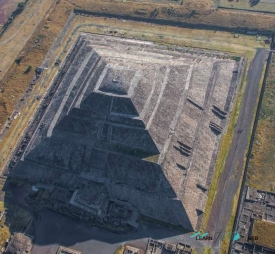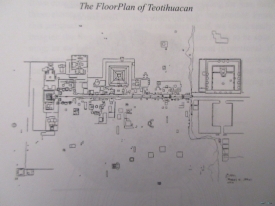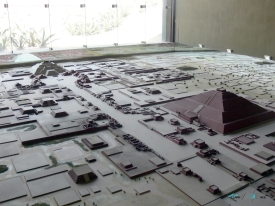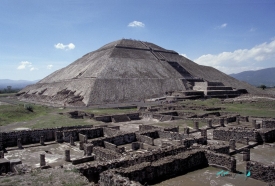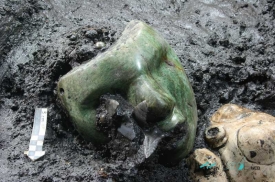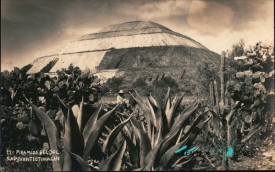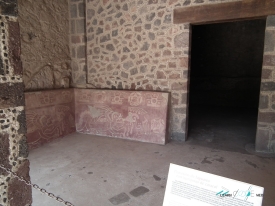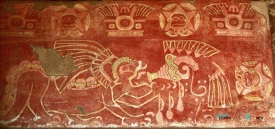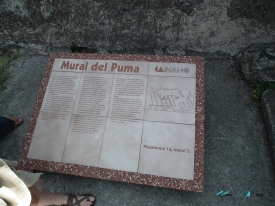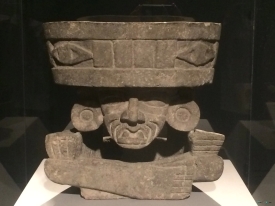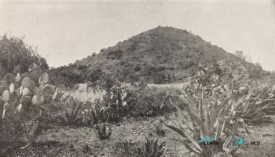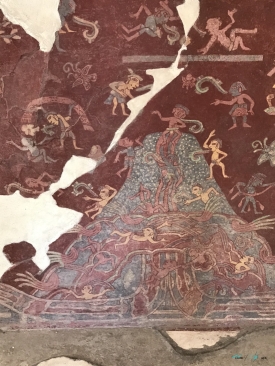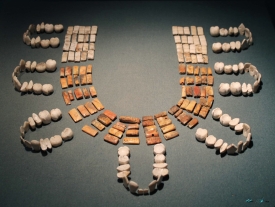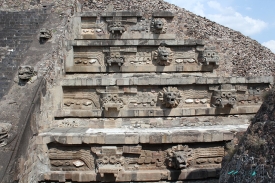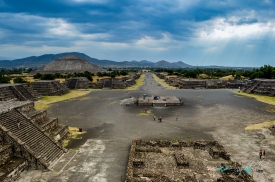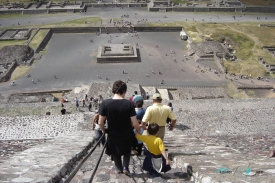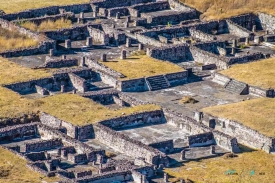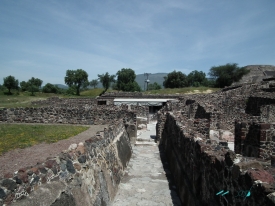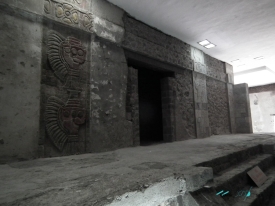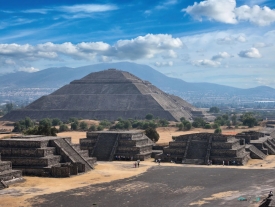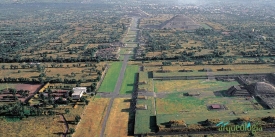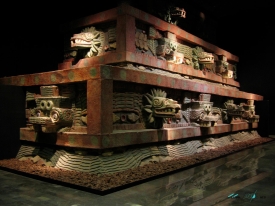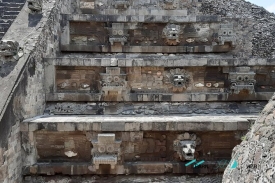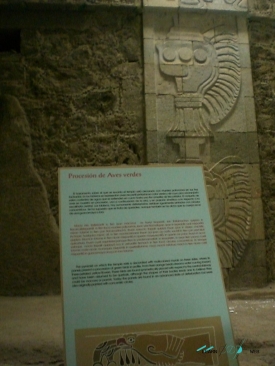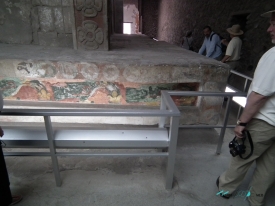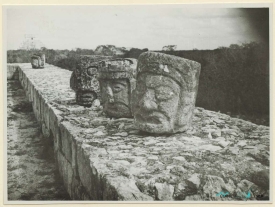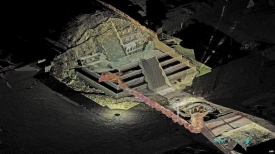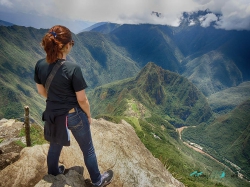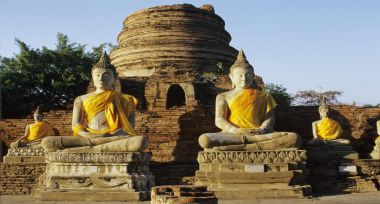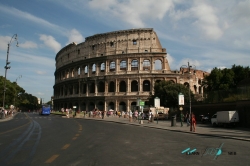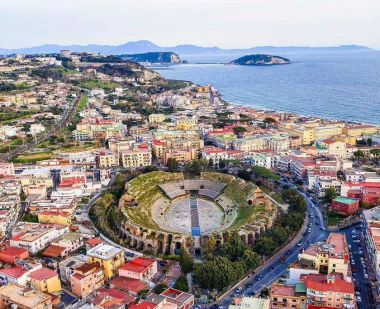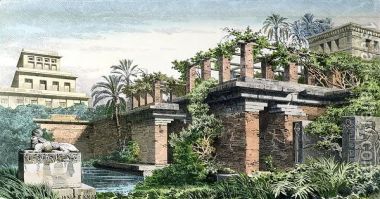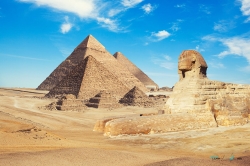ABOUT Teotihuacan
Teotihuacan (Teotihuacán) is an ancient Mesoamerican city located in a sub-valley of the Valley of Mexico, which is located in the State of Mexico, 40 kilometres (25 mi) northeast of modern-day Mexico City. Teotihuacan is known today as the site of many of the most architecturally significant Mesoamerican pyramids built in the pre-Columbian Americas. At its zenith, perhaps in the first half of the first millennium CE (1 CE to 500 CE), Teotihuacan was the largest city in the pre-Columbian Americas, with a population estimated at 125,000 or more, making it at least the sixth-largest city in the world during its epoch. After the collapse of Teotihuacan, central Mexico was dominated by the Toltecs of Tula until about 1150 CE.
The city covered 8 square miles; 80 to 90 percent of the total population of the valley resided in Teotihuacan. Apart from the pyramids, Teotihuacan is also anthropologically significant for its complex, multi-family residential compounds, the Avenue of the Dead, and its vibrant, well-preserved murals. Additionally, Teotihuacan exported fine obsidian tools that are found throughout Mesoamerica. The city is thought to have been established around 100 BCE, with major monuments continuously under construction until about 250 CE. The city may have lasted until sometime between the 7th and 8th centuries CE, but its major monuments were sacked and systematically burned around 550 CE.
Although it is a subject of debate whether Teotihuacan was the center of a state empire, its influence throughout Mesoamerica is well documented; evidence of Teotihuacano presence can be seen at numerous sites in Veracruz and the Maya region. The later Aztecs saw these magnificent ruins and claimed a common ancestry with the Teotihuacanos, modifying and adopting aspects of their culture. The ethnicity of the inhabitants of Teotihuacan is the subject of debate. Possible candidates are the Nahua, Otomi or Totonac ethnic groups. Scholars have suggested that Teotihuacan was a multi-ethnic state since they find cultural aspects connected to the Maya as well as Oto-Pamean people.
Here are some of the key facts and highlights about Teotihuacan:
History: Teotihuacan was founded around 200 BCE and reached its peak between 150 CE and 450 CE. It was home to a multiethnic population and was a major hub for trade, commerce, and religion. The city declined and was abandoned by around 700 CE, and its history was largely forgotten until its rediscovery by archaeologists in the early 20th century.
Architecture: The city is home to many impressive architectural feats, including the Pyramid of the Sun, the Pyramid of the Moon, the Temple of the Feathered Serpent, and the Ciudadela, a large central plaza surrounded by temples and palaces. The layout of the city is marked by a grid-like system of streets and avenues, which converge at the center of the city.
Society: Little is known about the people who lived in Teotihuacan, as they left no written records. However, it is believed that the city was home to a complex and stratified society, with a ruling class that controlled the city's resources and a large working-class population.
Religion: Teotihuacan was a major religious center, and its temples and pyramids were dedicated to various gods and goddesses. The Feathered Serpent was one of the most important deities, and the temple dedicated to this god is one of the most impressive structures in the city.
Artifacts: Many important artifacts have been recovered from Teotihuacan, including stone carvings, murals, and pottery. Some of the most notable artifacts include the mural paintings found in the Temple of the Feathered Serpent, which depict the god and other important figures, as well as numerous small figurines that are thought to have been used in religious ceremonies.
Visitors: Teotihuacan is one of Mexico's most popular tourist destinations, and visitors from all over the world come to explore its ancient ruins, climb its pyramids, and learn about its rich history and culture. The site is easily accessible from Mexico City, and guided tours are available in a variety of languages.
UNESCO World Heritage Site: Teotihuacan was designated a UNESCO World Heritage Site in 1987, in recognition of its outstanding cultural and historical significance.
Overall, Teotihuacan is a fascinating and important archaeological site that offers a glimpse into the rich and complex history of ancient Mexico. Whether you are interested in history, architecture, art, or religion, there is something at Teotihuacan to capture your imagination and curiosity.
The city covered 8 square miles; 80 to 90 percent of the total population of the valley resided in Teotihuacan. Apart from the pyramids, Teotihuacan is also anthropologically significant for its complex, multi-family residential compounds, the Avenue of the Dead, and its vibrant, well-preserved murals. Additionally, Teotihuacan exported fine obsidian tools that are found throughout Mesoamerica. The city is thought to have been established around 100 BCE, with major monuments continuously under construction until about 250 CE. The city may have lasted until sometime between the 7th and 8th centuries CE, but its major monuments were sacked and systematically burned around 550 CE.
Although it is a subject of debate whether Teotihuacan was the center of a state empire, its influence throughout Mesoamerica is well documented; evidence of Teotihuacano presence can be seen at numerous sites in Veracruz and the Maya region. The later Aztecs saw these magnificent ruins and claimed a common ancestry with the Teotihuacanos, modifying and adopting aspects of their culture. The ethnicity of the inhabitants of Teotihuacan is the subject of debate. Possible candidates are the Nahua, Otomi or Totonac ethnic groups. Scholars have suggested that Teotihuacan was a multi-ethnic state since they find cultural aspects connected to the Maya as well as Oto-Pamean people.
Here are some of the key facts and highlights about Teotihuacan:
History: Teotihuacan was founded around 200 BCE and reached its peak between 150 CE and 450 CE. It was home to a multiethnic population and was a major hub for trade, commerce, and religion. The city declined and was abandoned by around 700 CE, and its history was largely forgotten until its rediscovery by archaeologists in the early 20th century.
Architecture: The city is home to many impressive architectural feats, including the Pyramid of the Sun, the Pyramid of the Moon, the Temple of the Feathered Serpent, and the Ciudadela, a large central plaza surrounded by temples and palaces. The layout of the city is marked by a grid-like system of streets and avenues, which converge at the center of the city.
Society: Little is known about the people who lived in Teotihuacan, as they left no written records. However, it is believed that the city was home to a complex and stratified society, with a ruling class that controlled the city's resources and a large working-class population.
Religion: Teotihuacan was a major religious center, and its temples and pyramids were dedicated to various gods and goddesses. The Feathered Serpent was one of the most important deities, and the temple dedicated to this god is one of the most impressive structures in the city.
Artifacts: Many important artifacts have been recovered from Teotihuacan, including stone carvings, murals, and pottery. Some of the most notable artifacts include the mural paintings found in the Temple of the Feathered Serpent, which depict the god and other important figures, as well as numerous small figurines that are thought to have been used in religious ceremonies.
Visitors: Teotihuacan is one of Mexico's most popular tourist destinations, and visitors from all over the world come to explore its ancient ruins, climb its pyramids, and learn about its rich history and culture. The site is easily accessible from Mexico City, and guided tours are available in a variety of languages.
UNESCO World Heritage Site: Teotihuacan was designated a UNESCO World Heritage Site in 1987, in recognition of its outstanding cultural and historical significance.
Overall, Teotihuacan is a fascinating and important archaeological site that offers a glimpse into the rich and complex history of ancient Mexico. Whether you are interested in history, architecture, art, or religion, there is something at Teotihuacan to capture your imagination and curiosity.
The Best Pictures of Teotihuacan
Videos of Teotihuacan















